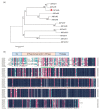CsCIPK11-Regulated Metalloprotease CsFtsH5 Mediates the Cold Response of Tea Plants
- PMID: 37047263
- PMCID: PMC10094637
- DOI: 10.3390/ijms24076288
CsCIPK11-Regulated Metalloprotease CsFtsH5 Mediates the Cold Response of Tea Plants
Abstract
Photosystem II repair in chloroplasts is a critical process involved in maintaining a plant's photosynthetic activity under cold stress. FtsH (filamentation temperature-sensitive H) is an essential metalloprotease that is required for chloroplast photosystem II repair. However, the role of FtsH in tea plants and its regulatory mechanism under cold stress remains elusive. In this study, we cloned a FtsH homolog gene in tea plants, named CsFtsH5, and found that CsFtsH5 was located in the chloroplast and cytomembrane. RT-qPCR showed that the expression of CsFtsH5 was increased with leaf maturity and was significantly induced by light and cold stress. Transient knockdown CsFtsH5 expression in tea leaves using antisense oligonucleotides resulted in hypersensitivity to cold stress, along with higher relative electrolyte leakage and lower Fv/Fm values. To investigate the molecular mechanism underlying CsFtsH5 involvement in the cold stress, we focused on the calcineurin B-like-interacting protein kinase 11 (CsCIPK11), which had a tissue expression pattern similar to that of CsFtsH5 and was also upregulated by light and cold stress. Yeast two-hybrid and dual luciferase (Luc) complementation assays revealed that CsFtsH5 interacted with CsCIPK11. Furthermore, the Dual-Luc assay showed that CsCIPK11-CsFtsH5 interaction might enhance CsFtsH5 stability. Altogether, our study demonstrates that CsFtsH5 is associated with CsCIPK11 and plays a positive role in maintaining the photosynthetic activity of tea plants in response to low temperatures.
Keywords: CsCIPK11; CsFtsH5; cold; photosynthetic activity; tea plant.
Conflict of interest statement
All the authors in the manuscript have no conflicts of interest.
Figures





Similar articles
-
CIPK11 phosphorylates GSTU23 to promote cold tolerance in Camellia sinensis.Plant Cell Environ. 2024 Dec;47(12):4786-4799. doi: 10.1111/pce.15070. Epub 2024 Aug 1. Plant Cell Environ. 2024. PMID: 39087790
-
Identification of the CsFtsH genes from Camellia sinensis reveals its potential role in leaf color phenotype.Gene. 2024 Nov 15;927:148672. doi: 10.1016/j.gene.2024.148672. Epub 2024 Jun 8. Gene. 2024. PMID: 38857713
-
Transcriptome sequencing dissection of the mechanisms underlying differential cold sensitivity in young and mature leaves of the tea plant (Camellia sinensis).J Plant Physiol. 2018 May-Jun;224-225:144-155. doi: 10.1016/j.jplph.2018.03.017. Epub 2018 Mar 31. J Plant Physiol. 2018. PMID: 29642051
-
Genome-Wide Identification and Expression Analysis of Calcineurin B-Like Protein and Calcineurin B-Like Protein-Interacting Protein Kinase Family Genes in Tea Plant.DNA Cell Biol. 2019 Aug;38(8):824-839. doi: 10.1089/dna.2019.4697. Epub 2019 Jul 11. DNA Cell Biol. 2019. PMID: 31295023
-
Quality control of Photosystem II: where and how does the degradation of the D1 protein by FtsH proteases start under light stress?--Facts and hypotheses.J Photochem Photobiol B. 2011 Jul-Aug;104(1-2):229-35. doi: 10.1016/j.jphotobiol.2011.01.016. Epub 2011 Jan 20. J Photochem Photobiol B. 2011. PMID: 21333546 Review.
Cited by
-
MsFtsH8 Enhances the Tolerance of PEG-Simulated Drought Stress by Boosting Antioxidant Capacity in Medicago sativa L.Plants (Basel). 2024 Oct 29;13(21):3025. doi: 10.3390/plants13213025. Plants (Basel). 2024. PMID: 39519944 Free PMC article.
-
mRNA-miRNA analyses reveal the involvement of CsbHLH1 and miR1446a in the regulation of caffeine biosynthesis in Camellia sinensis.Hortic Res. 2023 Dec 29;11(2):uhad282. doi: 10.1093/hr/uhad282. eCollection 2024 Feb. Hortic Res. 2023. PMID: 39686959 Free PMC article.
-
Genome-wide identification and comprehensive analysis of the FtsH gene family in wheat.Mol Biol Rep. 2025 Feb 3;52(1):186. doi: 10.1007/s11033-025-10243-6. Mol Biol Rep. 2025. PMID: 39899074
References
-
- Mishra N.P., Francke C., van Gorkom H.J., Ghanotakis D.F. Destructive role of singlet oxygen during aerobic illumi-nation of the photosystem II core complex. Biochim. Biophys. Acta. 1994;1186:81–90. doi: 10.1016/0005-2728(94)90138-4. - DOI
MeSH terms
Substances
Grants and funding
- U22A20499/National Natural Science Foundation of China
- 31870685/National Natural Science Foundation of China
- 1610212018007/Central Public Interest Scientific Institution Basal Research Fund
- 2022XTTGCY01-02/the Project for Collaborative Promotion of Major Technology of Zhejiang province
- CARS-19-01A/China Agriculture Research System of MOF and MARA
LinkOut - more resources
Full Text Sources

